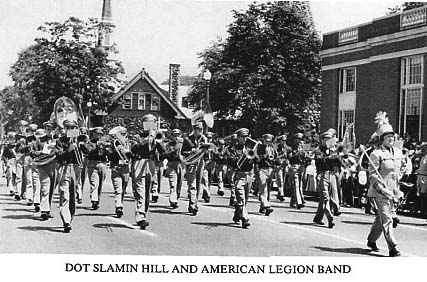
Contact Us
This site was created by the students at Waltham High School in the Youth Tech Entrepreneurs Class.
INCORPORATION AS A TOWN
What had been known as the Westerly Precinct of Watertown since it was explored by Gov. Winthrop in 1631 became officially incorporated as the town of Waltham on January 15, 1738. The town name is a Saxon word meaning “forest home”. It is generally thought the name was chosen because of Waltham Abbey in England; however it has not been clearly determined which of the several parishes in England named Waltham provided the inspiration.

In 1722 the center of religious and political activity was the meeting house purchased from the town of Newton by the farmers who had settled in this area. The house was moved to what is now Lyman Street. It was only a matter of time before the farmers overcame the opposition of the East Precinct and were successful in separating from Watertown and forming their own independent political entity.
The number of inhabitants at the time of incorporation in 1738 was about 550. They lived mainly in the vicinity of Trapelo Road and Beaver Street in the district known as Trapelo and Pond End. The farm houses were scattered throughout the area with the nearest semblance to a village being the inn and a few houses located between Beaver Brook and Pleasant Street. As the main highway between Boston and New York, Main Street, then known as Sudbury Road or the Great Country Road, was the heaviest traveled in the area. Along this road passed much of the trade and commerce of Massachusetts. People traveling on the stagecoach from Boston to points west would pass through Waltham. Undoubtedly Waltham's many fine taverns offering food, drink and lodging were a welcome sight to the weary traveler. Prominent among these old taverns was the Central House, located where the Waltham Public Library stands today. Before Lexington Street was opened in the mid 1800's, many stagecoaches and teams used old Forest Street because it was the most direct route to Lexington and Lowell.

In 1767 a new meeting house was built near the old one on the triangle formed by Lyman Street and the two branches of Beaver Street. The first church bell in Waltham, according to tradition, was made by Paul Revere, and placed in the steeple of this building in 1815. It was also, in 1770, the site of the first recorded fire in the town when the steeple was struck by lightning. The fire was extinguished with a pail of milk by a farm hand who was milking nearby. When repairs were made, the first lightning rods in town were added, a fact which was noted in a letter of John Winthrop to Benjamin Franklin.

The little farm town was growing. In 1761 the first bridge in Waltham over the Charles River was built in cooperation with Newton at Newton Street. In 1733 the first school was built near what is now the junction of Bacon and Lexington Streets. By 1775 there were three schools in the town.
AMERICAN REVOLUTION AND FEDERALIST PERIOD
Waltham citizens took an active part in national events. Almost 300 men represented Waltham in the American Revolution. On April 19, 1775 a militia company met at the Meeting House where their arms were hidden. They then marched to Piety Corner where they were held until it was determined whether the British were returning from Concord by way of the Great Road or by way of Lexington.
When the latter route was reported, they marched off towards Lexington. Tradition says that at least some of this company served in Lexington in the early morning hours of the nineteenth. A company of Waltham soldiers was in the Battle of Bunker Hill and many served in the Continental Army. During the winter of 1775-76, which George Washington spent with the troops in Cambridge, he was entertained at the home of his friend, Cornet Nathaniel Bridge on Trapelo Road.
In 1776, the town voted to approve the Declaration of Independence, and in 1778 it voted to support the ratification of the Articles of Confederation. Jonas Dix, Esq. and Capt. Jonas Clarke were elected as delegates to the Constitutional Convention. When the new constitution was sent to the state for ratification the Waltham delegate to the Massachusetts Convention, Leonard Williams, was one of a minority from Middlesex County who voted in favor of it.
In 1789 two distinguished citizens of the infant Republic passed through Waltham along the Great Country Road. In April Vice President-elect John Adams stopped at the Stratton Tavern on Weston St. for breakfast as he journeyed from Boston to New York to his inauguration. In October President George Washington was escorted through Waltham and Watertown to Cambridge by the Waltham Cavalry Troop.
Holidays during the early years of the nineteenth century provided a touch of excitement for our local citizens. On the Fourth of July, parades would be held, bells rung and cannons fired. October 19th, the anniversary of the surrender of Lord Cornwallis at Yorktown, was a major holiday. Ellen Lane, a resident of Waltham during this period, described October 19th as ”...a great day, not only for us, but all the country around. All roads led to Waltham that day and the people would come early in all kinds of vehicles and stay during the day. Bakers' carts, packed with pies, gingerbread and seed cakes, and venders of candy, popped corn and peanuts were on the grounds all day. The great attraction was the military gathering. Some stalwart young man would impersonate Lord Cornwallis. Then came the British redcoats, the old Continentals, and the trained militias...They would all join the parade through town and then repair to the field and all join in a sham fight..."
GORE ESTATE
With its easy access to Boston and its beautiful surroundings, Waltham soon became the summer home for two wealthy Bostonians: Christopher Gore and Theodore Lyman. In 1785 Christopher and his wife Rebecca purchased forty acres of land in Waltham. Eventually the Gores would own about 400 acres of land at their Waltham farm. While in England, the Gores were notified that their wooden house in Waltham had burned down. Immediately plans were made to build a more beautiful, elaborate structure. They studied various English estates and, after consulting with the French architect Jacques-Guillaume Legrand, construction began on the Gores' new Waltham estate in March of 1805.

Materials were brought up the Charles River to Watertown by raft and then transported to Waltham via the Great Country Road. The estate, constructed of brick, is still standing today and is one of the finest examples of Federalist architecture in the United States. The interior features oval rooms, marble floors, and a spiral staircase. Gore was able to build the house for under $24,000. Until his death in 1829, Christopher Gore spent at least half of every year at his Waltham estate. As a prominent national figure (he served as both Governor and Senator), Gore was able to entertain his many guests in a lavish and gracious setting at Gore Place.
LYMAN ESTATE
In 1793, Boston merchant Theodore Lyman and his wife Lydia purchased the Dix Estate in Waltham. Samuel McIntire, a well known Salem architect, was hired to design a fine “country estate” for the Lymans. The Lyman Estate was also built in the Federalist style, and featured an oval room and a grand ball room. The beautifully landscaped grounds included a deer park, ponds, green houses, and flowing lawns.
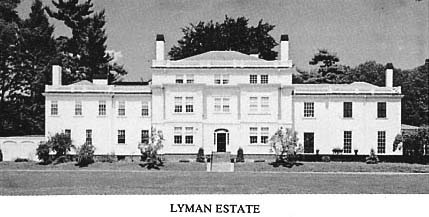
The population of the town in its early years increased steadily. In 1765 it was 663; in 1776 it was 870. Part of the drop of almost 200 in 1780 (689) can be accounted for by Revolutionary War casualties and the departure of some families interested in settling more remote parts of New England. For example, in 1779 several families under the leadership of Deacon Elizah Livermore founded the town of Livermore, Maine. The first census taken by the United States government in 1790 showed Waltham's population had grown to 882. As the population grew, events took place which would have a profound effect on the direction the town would take.
EARLY INDUSTRIES
In 1788, John Boies built the first dam across the Charles River in Waltham and erected a paper mill. The Boies Mill stood just below the Moody Street Falls, on the north bank of the river. Six years later, Christopher Gore built a rival paper mill along the banks of the Charles River near the Watertown line. A third paper mill built byNathan Upham along Stony Brook in 1802 was known by generations of Walthamites as the Roberts Paper Mill.
With the Industrial Revolution already in full swing in England, it was only a question of time before the era of small mills and homespun cloth would come to an end in America. Waltham, more than any other town in the United States, was destined to play a key role in this nation's transformation from an agrarian to an industrial society.
Waltham's first large factory was known as the Waltham Cotton and Wool Company. Incorporated in 1812, the company was located on the north bank of the Charles River on the Watertown line (the site of Governor Gore's paper mill). The factory grew rapidly and soon employed over 200 workers.
BOSTON MANUFACTURING COMPANY (BMC)
While the Waltham Cotton and Wool Factory was commencing operations, a young Boston merchant by the name of Francis Cabot Lowell returned to the United States from England where he had been touring British textile mills. Lowell had paid particular attention to the power loom, a machine which had yet to be replicated in America. He began to plan the establishment of a large water- powered cotton mill able to perform all of the steps necessary to manufacture cloth under one roof. Various wealthy Bostonians, including Patrick Tracy Jackson and Nathan Appleton, invested the necessary capital to launch the new company, which would be incorporated as the Boston Manufacturing Company (BMC).

In September 1813 Lowell and his partners purchased the Boies Paper Mill in Waltham for $1000. The ten foot drop in the river, the large natural lake above the falls, and the proximity of the Great Country Road helped make this an ideal location. A skilled master mechanic from the town of Amesbury, Paul Moody, was hired to construct the textile machinery and oversee the building of the mill. Paul Moody guaranteed the success of the BMC by constructing the first successful American power loom and went on to provide the company with one new technological breakthrough after another.
Construction on the mill was completed in November 1814, and by the following year cloth manufactured in Waltham was for sale in Boston. This marked a major turning point in the Industrial Revolution. For the first time anywhere in the world, all of the processes of manufacturing cotton cloth were performed under one roof using machinery operated by power.
Because Waltham did not have a large laboring force, the mill owners imported young farm girls from the surrounding area to come to Waltham to work the machines. The mill girls, as they came to be known, lived in company houses supervised by older women who were employed by the company as substitute mothers. This system of providing supervised, company owned boarding houses for young women employees (utilized to an even greater extent by the Watch Factory) became known nationwide as the Waltham System.
The mill girls employed by the Boston Manufacturing Company worked approximately eighty hours per week. At 4:40 in the morning the factory bell would awaken the workers. They would report to work at 5:00 and have a half hour breakfast break at 7:00 a.m. They would then work until the half hour to forty-five minute lunch break at noon time. At 7:00 p.m. the factory would shut down and the workers would return to their company houses. This routine was followed six days a week.
In 1818 a second larger mill was constructed next to the original building and one year after the struggling Waltham Cotton and Wool Factory was purchased for $16,000. A new brick cotton mill was built on this site as was a large brick bleachery. The Waltham Bleachery and Dye Works remained in business until 1951 when the buildings were taken over by Raytheon. People who live in the neighborhood around the Waltham Bleachery still refer to the area as the Bleachery section of Waltham.
NEWTON CHEMICAL COMPANY
Dr. Samuel Dana and the owners of the Boston Manufacturing Company established the Newton Chemical Company in 1825 to manufacture oil of vitriol and bleaching salts for the Waltham Bleachery and Dye Works.
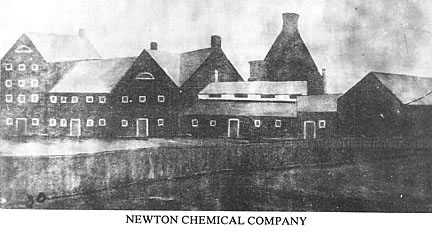
The company was built south of the Charles River in the Newton St. vicinity. It became part of Waltham when Waltham, after a dispute with Newton over the repair of a bridge, bought the South Side in 1849 for $1,000. At one time the Newton Chemical Company owned about an eighth of the land on the South Side.
When a cheaper process for making sulfuric acid forced it out of business in the 1870's, the company tore down the buildings and laid out its property in house lots, many of which were purchased by the Watch Factory. The Newton Chemical Company left as an abiding legacy a good deal of the South Side as it exists today and a region of the city called “the Chemistry” (Newton St./Pine St. area).
WALTHAM IN THE FIRST HALF OF THE NINETEENTH CENTURY
Throughout its early history, the BMC was recognized as one of the finest and most prosperous factories in the United States. Dignitaries such as Senator John C. Calhoun of South Carolina and President James Monroe came to Waltham to view first-hand this new system of manufacturing. In addition to its national significance, the BMC permanently changed Waltham from an agricultural to an industrial community. It was also responsible for establishing three schools for the children of factory employees and creating Waltham's first fire department in 1817 by purchasing a fine engine. The town of Waltham was allowed to use the fire engine under the stipulation the town would appoint men to operate it.

Waltham's population began to grow, increasing sixty-five percent from 1810 to 1820. With new neighborhoods growing around the mills, the population center of Waltham shifted from the farming regions of North Waltham to the industrial area around the Charles River.
RUMFORD HALL
The cultural life the town also grew, particularly with the formation of the Rumford Institute. The Institute was to provide lectures, concerts, plays and debates for its members and had use of a large room in Rumford Hall, which was built in 1827 by the BMC at the corner of Elm Street and the Great Country Road. Over the years a number of nationally famous individuals lectured at Rumford Hall, including Daniel Webster, Charles Sumner, Edward Everett, Ralph Waldo Emerson, and Oliver Wendell Holmes. Rumford Hall was used as the town hail and, later, the city hall.
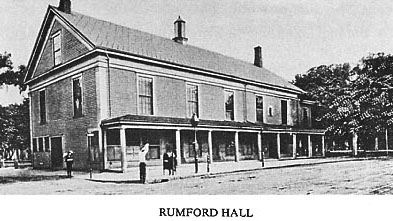
As the nineteenth century progressed, Waltham became more and more industrialized. Small businesses began to proliferate throughout the town. They included foundries, machine shops, tool shops connected with watch making, paper mills, a tannery and shoe factory. Some specific examples were Howard Clock, the O'Hara Dial, Judson L. Thompson, and the American Knitting Company.
WALTHAM WATCH FACTORY
In the nineteenth century three industries stand out as especially important. They are the BMC, the Newton Chemical Company and, of course, the Watch Factory. The Watch Factory was the industry which put Waltham on the global map.
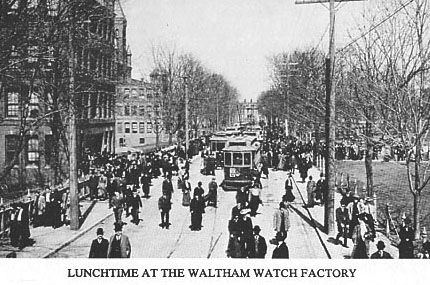
The factory was started in Roxbury by Aaron Dennison. It had different names, including the Boston Watch Company, when the first watches were made in 1850. It moved to Waltham in 1854 because more space and a less dusty area were needed. The company was a tour de force, a wonder, visited by such people as Ulysses S. Grant and the King of Hawaii. Its elaborate laboratory for testing and setting its watches was famous. It made an excellent product cheaply, manufacturing millions of watches, earning a world-renowned reputation and recruiting skilled watchmakers from England and Sweden. Its pay scale was far higher than that of the BMC and, not only did it provide fine working conditions, but also land and housing. If hard times caused a cut in pay, the officers cut their pay also. The workers had their own societies and band and joined all kinds of Waltham clubs.
An example of the growing industrialization in the town was evidenced by some of the categories that were judged at the Agricultural and Industrial Fair held in Waltham in 1857. These categories included cattle and dairy products; fruits, flowers, and plants; factory fabrics; manufactured fabrics; machinery; fine arts; chemicals; dentists and dental instruments; painting, binding, and stationery; a Charles River regatta; primary and other school drawings; and a spading contest (to band music).
CIVIL WAR
The largest monument on the common of every New England town is the one commemorating the Civil War. Waltham is no exception. Its population of about 5,000 in 1861 was just large enough for the town to raise its own company. On April 26, 1861, a Waltham town meeting approved the formation of Company H, a three year company attached to the Sixteenth Massachusetts Volunteers. The men drilled on a Common where the trees were still young, as were they, not knowing then which of them would see the Common again. The Waltham Light Dragoons, organized in 1853, formed the nucleus of two companies in the First Massachusetts Cavalry. As the war progressed, many other Massachusetts regiments also recruited Waltham men.
The April town meeting voted that the soldiers should have uniforms and $10 per month for five months, with provision for family support while they were gone. Further appropriations were also made according to state law. Later in the war, bounties were offered to make up the difference between what a man could earn at home and what the Army would pay him. The total number of men from Waltham who served in the Civil War was 700. Company H was mustered out in April, 1864 but, as in all companies, many men re-enlisted.
Waltham men made many noteworthy contributions. Nathaniel P. Banks attained the rank of Major-General in the Civil War and George Maynard received the Medal of Honor, the country's highest decoration, for courage shown at Fredricksburg.
WALTHAM IN THE SECOND HALF OF THE NINETEENTH CENTURY
From the mid-1800's on, various immigrant groups began to settle in Waltham. The first group to arrive in large numbers was the Irish, many of whom went to work at the BMC. They tended to live either near their church or the Mill. Although there were some of the usual adjustment problems, eventually native and foreign-born citizens began to understand each other.
The Rumford Institute continued to provide excellent lectures and other events. The Farmers' Club, which flourished in spite of the diminishing number of farmers, held discussions on other topics besides farming. The Everett Literary Association debated questions concerning current events. There were other debating teams, musical associations, bands, and fraternal lodges. The Watch Factory had its own band and aid society. There was a Firemen's Club and there was the militia.
Waltham was home to several newspapers. The Waltham Sentinel ran from 1856 to 1867. The Waltham Free Press began in1863 and merged with the Waltham Daily Tribune to become the Waltham Free Press Tribune; its descendent, the Waltham News Tribune, celebrated its centennial in 1984.
The foundation of the Waltham Public Library was the library of the Rumford Institute, given to the town, and its catalogue was printed in the Sentinel office. The library itself occupied more than one building until it acquired its own in 1914. Waltham High School, as a separate school, began in 1849.
There were many Protestant churches in Waltham but the coming of St. Mary's was different, because it was for immigrants rather than native born. The first St. Mary's Church was built in 1830 and burned in 1848. The Protestants of the town gave the parish $1,000 toward a new church building. By 1857 the town, because of pressure of population, had to establish a new cemetery and Mount Feake was acquired, although some older families continued to be buried in Grove Hill. In a similar way, the Archdiocese of Boston purchased Indian Hollow in 1867 as a cemetery called Calvary for both Waltham and Newton Catholics.
There were many public spirited citizens in Waltham evidenced by the founding of the Leland Home for Women in 1879; the Waltham Cottage Hospital in 1884, which became the Waltham Hospital in 1888; and the Waltham Training School for Nurses in1885, the first nurses' training school in the nation, founded by Dr. Alfred Worcester.
WALTHAM BECOMES A CITY
In 1884 Waltham changed to a city form of government. The event was marked with appropriate celebrations including a bonfire on Prospect Hill, a cannon volley and fireworks on the Common, and a Watch Factory Band Concert at Robbins Park.
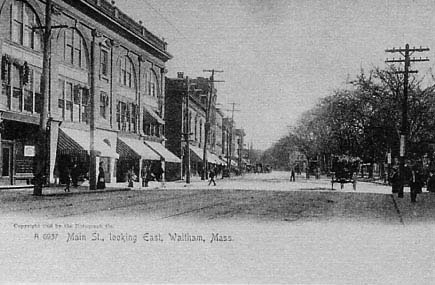
By this time there was a municipal fire department and police department. The city was rapidly expanding, particularly on the South Side. The Charles River had been bridged at Moody Street since 1841, and two years later the Fitchburg Branch of the Boston and Maine Railroad came to town and a trip to Boston became easy. In 1881 the Massachusetts Central came through on the Waltham North circuit and there was a Watertown Branch which ran through part of the South Side. Within the town, street railroads began. The first was on Moody and Crescent Streets in 1865 and the second on Main Street in 1887. Electric car service started in the 1890's. Streets were still unpaved and the horse was the usual means of transportation. Even on the main streets the new street railroads passed under over-arching trees by houses with white picket fences. The pleasure steamboat, White Swan, on which Charles Dickens once took a ride, traveled the Charles River that was clean and country-like in its upper stretches. Waltham in the mid and late 1800's was not only a pretty town but a flourishing one as well.
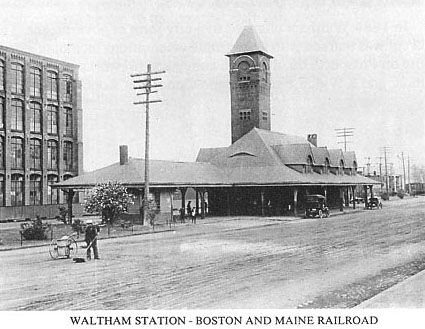
As the 19th century drew to a close, Waltham experienced unprecedented industrial growth and success. In the later 1800's to early 1900's there was a tremendous influx of immigrants from all over Europe seeking work and a better life in the United States. As was the case with many other cities and towns, Waltham saw a dramatic increase in its population. In 1884 44% of the city's population was Irish. It wasn't long before other ethnic groups arrived in noticeable numbers, particularly French Canadians and Italians. There were other smaller groups that also made Waltham their home such as Lithuanians, Poles, Russians, Belgians, Germans, and Armenians. They came to Waltham to find work in the Watch Factory and the BMC or in one of the scores of satellite industries which sprang up at the turn of the century. Women were an integral part of the immigrant movement and of the labor force, both as factory operatives and as domestics in boarding houses and private homes. In addition to evening classes that aided immigrants in obtaining citizenship, the BMC provided lunch-hour classes in the factory under the auspices of Waltham's Americanization program. Once they left the mills, these new citizens became involved with various aspects of Waltham's commercial world.
The addition of large groups of newcomers led to the establishment of many more churches. Besides founding new churches, these immigrant groups banded together in social and self-help organizations, a number of which flourished during the first quarter of this century.
The 1890's also saw a change in Waltham's landscape. Beginning in the 1880's, the city of Cambridge petitioned for and received permission from the Commonwealth to obtain land in north and west Waltham for two reservoirs. Some 1400 laborers, mostly Italians, camped out in the Winter Street area while constructing these water basins.
In 1893 the Waltham Manufacturing Company, which built Orient bicycles, was founded. In that same year Bicycle Park, now Nipper Maher Park, opened for bicycle racing. Running was also a popular sport and in 1896 Pat Carroll established a national record for the mile of 4 min., 26 sec. There was more time for recreation and Norumbega Park opened in 1897.
METZ CAR COMPANY

In 1893, Charles Metz, a New York State bicycle racing champion, incorporated the Waltham Manufacturing Company to design and build his own bicycles, caled Orients. Metz made about 100,000 bicycles at the Rumford Avenue factory, and is credited with producing the first American motorcycle in 1898. The following year the company announced production of an electric runabout automobile. Charles Metz's association with the company ended in 1902. From 1903 until 1907 the company produced the Buckboard automobile, notable for its friction drive feature.
In 1909 the Waltham Manufacturing Company became known as the Metz Car Company and devoted itself exclusively to the manufacturing of automobiles.
In the 1910's the Watch Company began a period of financial and managerial distress which would characterize the final 40 years of the company's existence. The company was reorganized and a decision to reduce wages, among other changes, resulted in a strike in 1924 which lasted thirteen months and crippled the Watch City as some 3,900 workers left their benches.
WORLD WAR I
On April 2, 1917, the United States entered World War I, joining France and England against Imperial Germany. Company F of the 101st Infantry, 26th Yankee Division, which had been drilling at Bicycle Park, was called to serve overseas. Colonel Hansen, the company commander, became famous because of an incident during the Second Battle of the Maine at Chateau Thierry. He took over the battalion when the regiment's second battalion commander, Captain Leahy of Lawrence, was wounded and he said, “Lieutenant Hansen, the command is forward. See the boys through”.
THE GREAT DEPRESSION
During the 1920's, the Boston Manufacturing Company and the Waltham Watch Company experienced financial difficulties. In 1930 the BMC went out of business. The Watch Company managed to stay open for another 25 years. From 1929 on, the Depression deepened. People took whatever jobs they could find to save their homes and provide for their families. Many French Canadians returned to Canada. Other families doubled in apartments and houses to save on the rent. Despite the efforts, many people lost their homes and savings. There were WPA programs in Waltham which provided jobs for many people. War contracts during the 1940's caused a boom for Waltham's economy, with most industries refocusing their production. Even the Watch Company concentrated on the war effort, designing special timepieces.
PRE-WORLD WAR II
Although there were more and more cars in the late 1930's and early 1940's, horses and wagons could still be seen on the streets. Most of the milk deliveries were made by horse and wagon as were blocks of ice that were delivered to those houses displaying an ice card in the window specifying how many pounds were needed that day.
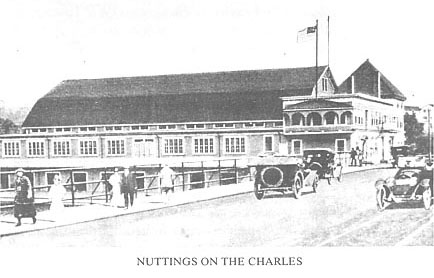
Besides scaling bubble gum cards against a wall to see who could get the closest, children played many street games such as hopscotch, marbles, tag, jump rope, and hide-n-seek. The Waltham Boys Club at the old Asbury Temple provided many recreational facilities. There was dancing at the Totem Pole in Newton and Nuttings-on-the-Charles in Waltham. On May 1, 1939, Glen Miller played at Nuttings. Movies were a major part of people's lives at this time and long lines could be seen waiting to get into the Embassy, Central or Waltham Theatres.
WORLD WAR II
In 1941 the European War was beginning to affect Waltham. On January 26, 1941, Co. F, the local National Guard unit operating out of the Waltham armory on Sharon St., was federalized.
On December 7, 1941 the Japanese bombed Pearl Harbor and the United States was at war. On that quiet Sunday those at the Embassy Theater were enjoying the movie “Great Guns” with Laurel and Hardy. Between the double feature the lights went on and the audience was stunned when the manager announced the bombing of Pearl Harbor.
The following month Co. F was shipped to Australia and word was received on October 14, 1942 that they had landed at Guadalcanal. On September 28th of that year, Mayor Arthur Hansen, a World War I hero, died of a heart attack on the Common during a War Bond rally. Many of Waltham's young men and women served their country in all branches of the armed services. A U.S.O. Club was opened on Main Street near Central Square.
POST WORLD WAR II
One of Waltham's greatest disasters occurred on March 6, 1948 when the Makalot plastic plant on South Street blew up killing six people. The explosion and vibration could be felt throughout Waltham.
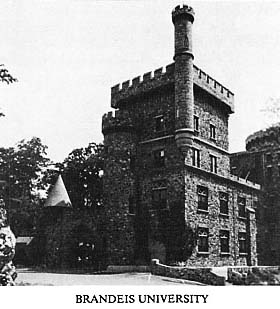
In 1948 Brandeis University moved into the former Middlesex Medical School on South Street. Brandeis has attracted outstanding scholars and is one of the prestigious universities in the nation. Waltham is also the home of Bentley College. Since arriving in the city in 1968, it has continually expanded. Students are attracted to the campus by its pleasant atmosphere and excellent reputation in the world of finance and business.
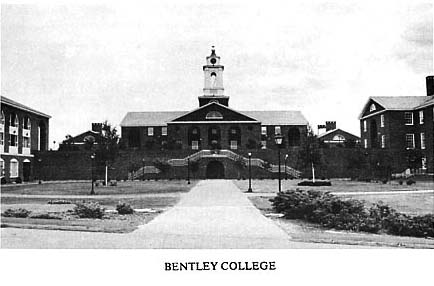
Since World War II many Waltham citizens have volunteered to serve their country in Korea and Vietnam.
For a number of years, particularly in the 1950's, major holidays were often observed by parades that attracted large numbers of spectators. Grover Cronin regularly sponsored Christmas and Easter Parades and the police and fire departments sponsored a July 4th parade.
HIGH TECH
Another major change of direction in the growth pattern of Waltham occurred in 1952 when the city rezoned a large tract of land along the newly planned Route 128 from residential to commercial. It brought a great deal of employment to the city, mostly in the electronics field. At this point, the city was changing from the Watch City to a high tech city.
In 1933, the electronics industry arrived in Waltham when Raytheon purchased the old Howell Button Factory on Willow Street. During World War I the company manufactured many of the magnetron tubes used in Allied radar system. Raytheon, one of the largest employers in Waltham, is a leader in the electronics industry with sales over $5 billion dollars.
ROUTE 128 OPENING
The completion of Route 128 in 1951 brought many more high tech firms to Waltham. Polaroid, built on the site of the H. L. Stone Dairy on upper Main Street, has become synonymous with instant photography. Other significant high tech firms found in Waltham include G.T.E., Sylvania, Honeywell, and Hewlett-Packard.
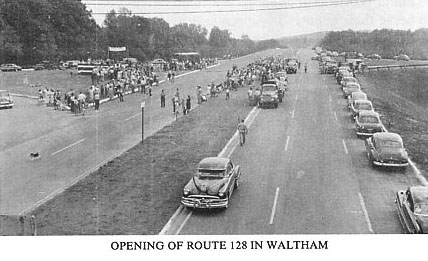
In the 1800's, Waltham assumed a position of leadership in the Industrial Revolution. Today Waltham continues to play a significant role in the fields of electronics and high technology.
CHANGING TIMES
A landmark was lost on June 18, 1961 when the Nuttings dance hall burned. Three years later the Totem Pole closed. Another landmark was lost to fire in 1965 when the Bleachery burned, and the biggest fire in Waltham occurred in March of 1970 at the Perrine Battery. The building that burned was the same one in which Charles Metz had made Orient bicycles, motorcycles, and cars at the turn of the century. The Embassy Theatre, which had opened in 1928, closed on May 7, 1972 and was subsequently torn down.
The pace of change has accelerated in Waltham as everywhere else. Apartment complexes and office buildings have proliferated. Some historical preservation has been undertaken. One of the most notable projects was the late 1970's renovation of the BMC factory buildings into elderly housing.
We are fortunate to have within our city three outstanding estates that provide a connecting link to our earliest history: the Gore Estate; the Lyman Estate; and the Robert Treat Paine Estate. The latter was deeded to the city in 1973 by the Paine family.
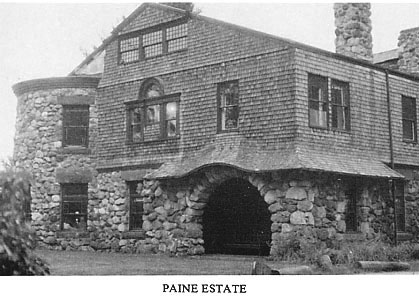
Evidence of the past is all around us—In the buildings, the place names and the heritage that has been passed on to us, the current citizens of Waltham. It is our responsibility to preserve the past so that future generations can appreciate the proud traditions that have made Waltham such a special place.
